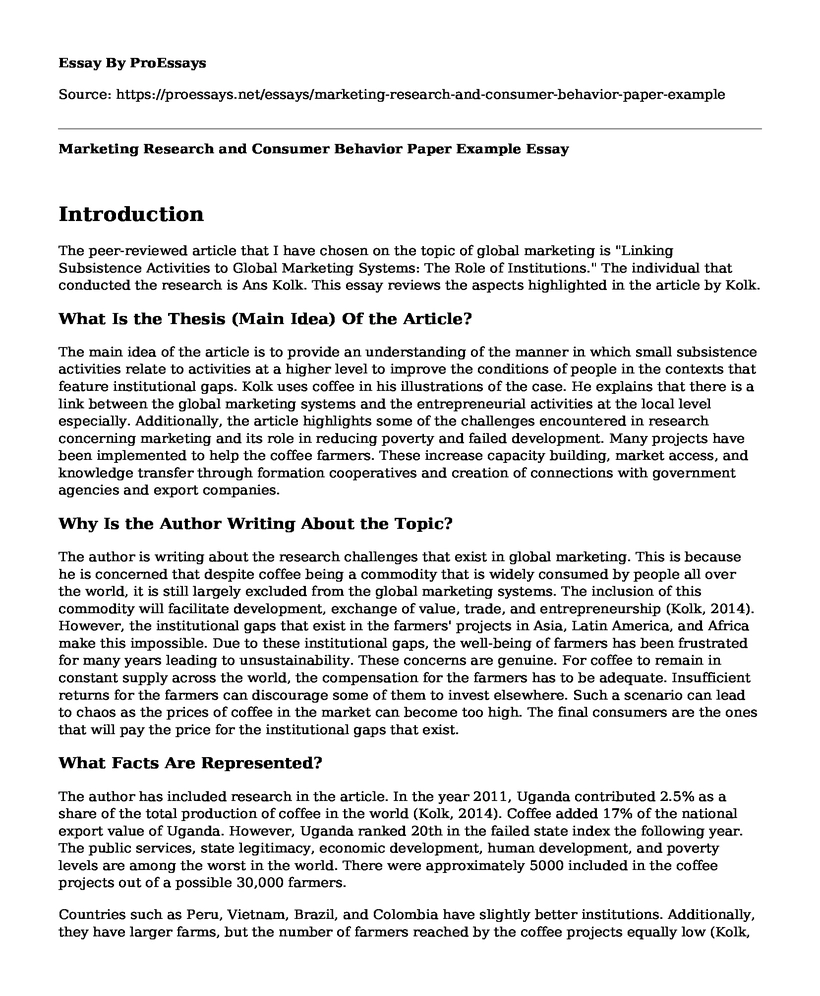Introduction
The peer-reviewed article that I have chosen on the topic of global marketing is "Linking Subsistence Activities to Global Marketing Systems: The Role of Institutions." The individual that conducted the research is Ans Kolk. This essay reviews the aspects highlighted in the article by Kolk.
What Is the Thesis (Main Idea) Of the Article?
The main idea of the article is to provide an understanding of the manner in which small subsistence activities relate to activities at a higher level to improve the conditions of people in the contexts that feature institutional gaps. Kolk uses coffee in his illustrations of the case. He explains that there is a link between the global marketing systems and the entrepreneurial activities at the local level especially. Additionally, the article highlights some of the challenges encountered in research concerning marketing and its role in reducing poverty and failed development. Many projects have been implemented to help the coffee farmers. These increase capacity building, market access, and knowledge transfer through formation cooperatives and creation of connections with government agencies and export companies.
Why Is the Author Writing About the Topic?
The author is writing about the research challenges that exist in global marketing. This is because he is concerned that despite coffee being a commodity that is widely consumed by people all over the world, it is still largely excluded from the global marketing systems. The inclusion of this commodity will facilitate development, exchange of value, trade, and entrepreneurship (Kolk, 2014). However, the institutional gaps that exist in the farmers' projects in Asia, Latin America, and Africa make this impossible. Due to these institutional gaps, the well-being of farmers has been frustrated for many years leading to unsustainability. These concerns are genuine. For coffee to remain in constant supply across the world, the compensation for the farmers has to be adequate. Insufficient returns for the farmers can discourage some of them to invest elsewhere. Such a scenario can lead to chaos as the prices of coffee in the market can become too high. The final consumers are the ones that will pay the price for the institutional gaps that exist.
What Facts Are Represented?
The author has included research in the article. In the year 2011, Uganda contributed 2.5% as a share of the total production of coffee in the world (Kolk, 2014). Coffee added 17% of the national export value of Uganda. However, Uganda ranked 20th in the failed state index the following year. The public services, state legitimacy, economic development, human development, and poverty levels are among the worst in the world. There were approximately 5000 included in the coffee projects out of a possible 30,000 farmers.
Countries such as Peru, Vietnam, Brazil, and Colombia have slightly better institutions. Additionally, they have larger farms, but the number of farmers reached by the coffee projects equally low (Kolk, 2014). This is one of the institutional gaps that have contributed to the lack of improvement of the well-being of farmers across Uganda. The facts represented in the article show that these institutional gaps are part of the problems that slow economic growth in developing countries.
How Does It Relate To Other Readings on the Topic?
There is a relationship between the issues highlighted in this text and other readings on the topic. Some of the challenges of global marketing that have been highlighted in the topic include administrative policies and the political environment - these external factors that contribute to the challenges that farmers face. For instance, when the respective governments implement poor administrative policies, they can prevent the institutional gaps from being sealed. An unstable political environment can also make it expensive to export the commodity hence the very little funds will be compensated to the farmers.
What are the Conclusions and Recommendations?
Upon a complete review of the article by Kolk, I have concluded that the challenges addressed are a realistic analysis of the situation of farmers on the ground. Most cash crops are sold at very high prices in retail outlets. However, very little of the revenue generated from the sales reach the farmers. For this reason, most farmers in these countries have to endure harsh conditions of farming when they could easily afford farm machinery when compensated as they should. I recommend that farmers should focus on strengthening their position in the market by forming producer groups and establish a direct link with the exporters. Through such groups, they can also market their coffee in international markets.
Critique of the Article
Even though the article does not have many weaknesses, it fails to highlight the challenges that farmers face when dealing in other varieties of export crops. Do these farmers face the same challenges as coffee farmers? Are their institutions better or worse? Also, the article fails to give credit to the little efforts that have been put in place by institutions in the respective countries to address the challenges that their farmers are facing.
Reference
Kolk, A. (2014). Linking subsistence activities to global marketing systems: The role of institutions. Journal of Macromarketing, 34(2), 186-198.
Cite this page
Marketing Research and Consumer Behavior Paper Example. (2022, Nov 06). Retrieved from https://proessays.net/essays/marketing-research-and-consumer-behavior-paper-example
If you are the original author of this essay and no longer wish to have it published on the ProEssays website, please click below to request its removal:
- Rhetorical Analysis: Blink Fitness Body Positive Advertisement
- The Influence of the FIFA 2018 on the Quality of Service Offered in Russia Paper Example
- How Marketers Compel Customers to Buy Products? - Essay Sample
- Organizational Analysis Report: St. Jude's Children Research Hospital
- Essay Example on Survival in a Changing World: The Power of an Effective Strategic Plan
- Free Report Sample on Fundraising for Nonprofits
- Evaluating the External Environment - Free Essay Example







